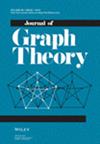多图维京定理的局部版本
IF 1
3区 数学
Q2 MATHEMATICS
Clinton T. Conley, Jan Grebík, Oleg Pikhurko
{"title":"多图维京定理的局部版本","authors":"Clinton T. Conley, Jan Grebík, Oleg Pikhurko","doi":"10.1002/jgt.23155","DOIUrl":null,"url":null,"abstract":"<p>Extending a result of Christiansen, we prove that every multigraph <span></span><math>\n <semantics>\n <mrow>\n \n <mrow>\n <mi>G</mi>\n \n <mo>=</mo>\n \n <mrow>\n <mo>(</mo>\n \n <mrow>\n <mi>V</mi>\n \n <mo>,</mo>\n \n <mi>E</mi>\n </mrow>\n \n <mo>)</mo>\n </mrow>\n </mrow>\n </mrow>\n <annotation> $G=(V,E)$</annotation>\n </semantics></math> admits a proper edge colouring <span></span><math>\n <semantics>\n <mrow>\n \n <mrow>\n <mi>ϕ</mi>\n \n <mo>:</mo>\n \n <mi>E</mi>\n \n <mo>→</mo>\n \n <mrow>\n <mo>{</mo>\n \n <mrow>\n <mn>1</mn>\n \n <mo>,</mo>\n \n <mn>2</mn>\n \n <mo>,</mo>\n \n <mo>…</mo>\n <mspace></mspace>\n </mrow>\n \n <mo>}</mo>\n </mrow>\n </mrow>\n </mrow>\n <annotation> $\\phi :E\\to \\{1,2,\\ldots \\,\\}$</annotation>\n </semantics></math> which is <i>local</i>, that is, <span></span><math>\n <semantics>\n <mrow>\n \n <mrow>\n <mi>ϕ</mi>\n \n <mrow>\n <mo>(</mo>\n \n <mi>e</mi>\n \n <mo>)</mo>\n </mrow>\n \n <mo>⩽</mo>\n \n <mi>max</mi>\n \n <mrow>\n <mo>{</mo>\n \n <mrow>\n <mi>d</mi>\n \n <mrow>\n <mo>(</mo>\n \n <mi>x</mi>\n \n <mo>)</mo>\n </mrow>\n \n <mo>+</mo>\n \n <mi>π</mi>\n \n <mrow>\n <mo>(</mo>\n \n <mi>x</mi>\n \n <mo>)</mo>\n </mrow>\n \n <mo>,</mo>\n \n <mi>d</mi>\n \n <mrow>\n <mo>(</mo>\n \n <mi>y</mi>\n \n <mo>)</mo>\n </mrow>\n \n <mo>+</mo>\n \n <mi>π</mi>\n \n <mrow>\n <mo>(</mo>\n \n <mi>y</mi>\n \n <mo>)</mo>\n </mrow>\n </mrow>\n \n <mo>}</mo>\n </mrow>\n </mrow>\n </mrow>\n <annotation> $\\phi (e)\\leqslant \\max \\{d(x)+\\pi (x),d(y)+\\pi (y)\\}$</annotation>\n </semantics></math> for every edge <span></span><math>\n <semantics>\n <mrow>\n \n <mrow>\n <mi>e</mi>\n </mrow>\n </mrow>\n <annotation> $e$</annotation>\n </semantics></math> with end-points <span></span><math>\n <semantics>\n <mrow>\n \n <mrow>\n <mi>x</mi>\n \n <mo>,</mo>\n \n <mi>y</mi>\n \n <mo>∈</mo>\n \n <mi>V</mi>\n </mrow>\n </mrow>\n <annotation> $x,y\\in V$</annotation>\n </semantics></math>, where <span></span><math>\n <semantics>\n <mrow>\n \n <mrow>\n <mi>d</mi>\n \n <mrow>\n <mo>(</mo>\n \n <mi>z</mi>\n \n <mo>)</mo>\n </mrow>\n </mrow>\n </mrow>\n <annotation> $d(z)$</annotation>\n </semantics></math> (resp. <span></span><math>\n <semantics>\n <mrow>\n \n <mrow>\n <mi>π</mi>\n \n <mrow>\n <mo>(</mo>\n \n <mi>z</mi>\n \n <mo>)</mo>\n </mrow>\n </mrow>\n </mrow>\n <annotation> $\\pi (z)$</annotation>\n </semantics></math>) denotes the degree of a vertex <span></span><math>\n <semantics>\n <mrow>\n \n <mrow>\n <mi>z</mi>\n </mrow>\n </mrow>\n <annotation> $z$</annotation>\n </semantics></math> (resp. the maximum edge multiplicity at <span></span><math>\n <semantics>\n <mrow>\n \n <mrow>\n <mi>z</mi>\n </mrow>\n </mrow>\n <annotation> $z$</annotation>\n </semantics></math>). This is derived from a local version of the Fan Equation.</p>","PeriodicalId":16014,"journal":{"name":"Journal of Graph Theory","volume":"107 4","pages":"693-701"},"PeriodicalIF":1.0000,"publicationDate":"2024-07-16","publicationTypes":"Journal Article","fieldsOfStudy":null,"isOpenAccess":false,"openAccessPdf":"https://onlinelibrary.wiley.com/doi/epdf/10.1002/jgt.23155","citationCount":"0","resultStr":"{\"title\":\"Local version of Vizing's theorem for multigraphs\",\"authors\":\"Clinton T. Conley, Jan Grebík, Oleg Pikhurko\",\"doi\":\"10.1002/jgt.23155\",\"DOIUrl\":null,\"url\":null,\"abstract\":\"<p>Extending a result of Christiansen, we prove that every multigraph <span></span><math>\\n <semantics>\\n <mrow>\\n \\n <mrow>\\n <mi>G</mi>\\n \\n <mo>=</mo>\\n \\n <mrow>\\n <mo>(</mo>\\n \\n <mrow>\\n <mi>V</mi>\\n \\n <mo>,</mo>\\n \\n <mi>E</mi>\\n </mrow>\\n \\n <mo>)</mo>\\n </mrow>\\n </mrow>\\n </mrow>\\n <annotation> $G=(V,E)$</annotation>\\n </semantics></math> admits a proper edge colouring <span></span><math>\\n <semantics>\\n <mrow>\\n \\n <mrow>\\n <mi>ϕ</mi>\\n \\n <mo>:</mo>\\n \\n <mi>E</mi>\\n \\n <mo>→</mo>\\n \\n <mrow>\\n <mo>{</mo>\\n \\n <mrow>\\n <mn>1</mn>\\n \\n <mo>,</mo>\\n \\n <mn>2</mn>\\n \\n <mo>,</mo>\\n \\n <mo>…</mo>\\n <mspace></mspace>\\n </mrow>\\n \\n <mo>}</mo>\\n </mrow>\\n </mrow>\\n </mrow>\\n <annotation> $\\\\phi :E\\\\to \\\\{1,2,\\\\ldots \\\\,\\\\}$</annotation>\\n </semantics></math> which is <i>local</i>, that is, <span></span><math>\\n <semantics>\\n <mrow>\\n \\n <mrow>\\n <mi>ϕ</mi>\\n \\n <mrow>\\n <mo>(</mo>\\n \\n <mi>e</mi>\\n \\n <mo>)</mo>\\n </mrow>\\n \\n <mo>⩽</mo>\\n \\n <mi>max</mi>\\n \\n <mrow>\\n <mo>{</mo>\\n \\n <mrow>\\n <mi>d</mi>\\n \\n <mrow>\\n <mo>(</mo>\\n \\n <mi>x</mi>\\n \\n <mo>)</mo>\\n </mrow>\\n \\n <mo>+</mo>\\n \\n <mi>π</mi>\\n \\n <mrow>\\n <mo>(</mo>\\n \\n <mi>x</mi>\\n \\n <mo>)</mo>\\n </mrow>\\n \\n <mo>,</mo>\\n \\n <mi>d</mi>\\n \\n <mrow>\\n <mo>(</mo>\\n \\n <mi>y</mi>\\n \\n <mo>)</mo>\\n </mrow>\\n \\n <mo>+</mo>\\n \\n <mi>π</mi>\\n \\n <mrow>\\n <mo>(</mo>\\n \\n <mi>y</mi>\\n \\n <mo>)</mo>\\n </mrow>\\n </mrow>\\n \\n <mo>}</mo>\\n </mrow>\\n </mrow>\\n </mrow>\\n <annotation> $\\\\phi (e)\\\\leqslant \\\\max \\\\{d(x)+\\\\pi (x),d(y)+\\\\pi (y)\\\\}$</annotation>\\n </semantics></math> for every edge <span></span><math>\\n <semantics>\\n <mrow>\\n \\n <mrow>\\n <mi>e</mi>\\n </mrow>\\n </mrow>\\n <annotation> $e$</annotation>\\n </semantics></math> with end-points <span></span><math>\\n <semantics>\\n <mrow>\\n \\n <mrow>\\n <mi>x</mi>\\n \\n <mo>,</mo>\\n \\n <mi>y</mi>\\n \\n <mo>∈</mo>\\n \\n <mi>V</mi>\\n </mrow>\\n </mrow>\\n <annotation> $x,y\\\\in V$</annotation>\\n </semantics></math>, where <span></span><math>\\n <semantics>\\n <mrow>\\n \\n <mrow>\\n <mi>d</mi>\\n \\n <mrow>\\n <mo>(</mo>\\n \\n <mi>z</mi>\\n \\n <mo>)</mo>\\n </mrow>\\n </mrow>\\n </mrow>\\n <annotation> $d(z)$</annotation>\\n </semantics></math> (resp. <span></span><math>\\n <semantics>\\n <mrow>\\n \\n <mrow>\\n <mi>π</mi>\\n \\n <mrow>\\n <mo>(</mo>\\n \\n <mi>z</mi>\\n \\n <mo>)</mo>\\n </mrow>\\n </mrow>\\n </mrow>\\n <annotation> $\\\\pi (z)$</annotation>\\n </semantics></math>) denotes the degree of a vertex <span></span><math>\\n <semantics>\\n <mrow>\\n \\n <mrow>\\n <mi>z</mi>\\n </mrow>\\n </mrow>\\n <annotation> $z$</annotation>\\n </semantics></math> (resp. the maximum edge multiplicity at <span></span><math>\\n <semantics>\\n <mrow>\\n \\n <mrow>\\n <mi>z</mi>\\n </mrow>\\n </mrow>\\n <annotation> $z$</annotation>\\n </semantics></math>). This is derived from a local version of the Fan Equation.</p>\",\"PeriodicalId\":16014,\"journal\":{\"name\":\"Journal of Graph Theory\",\"volume\":\"107 4\",\"pages\":\"693-701\"},\"PeriodicalIF\":1.0000,\"publicationDate\":\"2024-07-16\",\"publicationTypes\":\"Journal Article\",\"fieldsOfStudy\":null,\"isOpenAccess\":false,\"openAccessPdf\":\"https://onlinelibrary.wiley.com/doi/epdf/10.1002/jgt.23155\",\"citationCount\":\"0\",\"resultStr\":null,\"platform\":\"Semanticscholar\",\"paperid\":null,\"PeriodicalName\":\"Journal of Graph Theory\",\"FirstCategoryId\":\"100\",\"ListUrlMain\":\"https://onlinelibrary.wiley.com/doi/10.1002/jgt.23155\",\"RegionNum\":3,\"RegionCategory\":\"数学\",\"ArticlePicture\":[],\"TitleCN\":null,\"AbstractTextCN\":null,\"PMCID\":null,\"EPubDate\":\"\",\"PubModel\":\"\",\"JCR\":\"Q2\",\"JCRName\":\"MATHEMATICS\",\"Score\":null,\"Total\":0}","platform":"Semanticscholar","paperid":null,"PeriodicalName":"Journal of Graph Theory","FirstCategoryId":"100","ListUrlMain":"https://onlinelibrary.wiley.com/doi/10.1002/jgt.23155","RegionNum":3,"RegionCategory":"数学","ArticlePicture":[],"TitleCN":null,"AbstractTextCN":null,"PMCID":null,"EPubDate":"","PubModel":"","JCR":"Q2","JCRName":"MATHEMATICS","Score":null,"Total":0}
引用次数: 0
摘要
通过扩展克里斯蒂安森的一个结果,我们证明了每一个多图都有一个适当的边着色,这个边着色是局部的,也就是说,对于每一条有端点的边,(resp. )表示顶点的度数(resp. 最大边乘)。这是从范式方程的局部版本中推导出来的。本文章由计算机程序翻译,如有差异,请以英文原文为准。
Local version of Vizing's theorem for multigraphs
Extending a result of Christiansen, we prove that every multigraph admits a proper edge colouring which is local, that is, for every edge with end-points , where (resp. ) denotes the degree of a vertex (resp. the maximum edge multiplicity at ). This is derived from a local version of the Fan Equation.
求助全文
通过发布文献求助,成功后即可免费获取论文全文。
去求助
来源期刊

Journal of Graph Theory
数学-数学
CiteScore
1.60
自引率
22.20%
发文量
130
审稿时长
6-12 weeks
期刊介绍:
The Journal of Graph Theory is devoted to a variety of topics in graph theory, such as structural results about graphs, graph algorithms with theoretical emphasis, and discrete optimization on graphs. The scope of the journal also includes related areas in combinatorics and the interaction of graph theory with other mathematical sciences.
A subscription to the Journal of Graph Theory includes a subscription to the Journal of Combinatorial Designs .
×
引用
GB/T 7714-2015
复制
MLA
复制
APA
复制
导出至
BibTeX
EndNote
RefMan
NoteFirst
NoteExpress
请完成安全验证×
微信好友
朋友圈
QQ好友
复制链接
取消

已复制链接
快去分享给好友吧!
我知道了

点击右上角分享
相关文献
 求助内容:
求助内容: 应助结果提醒方式:
应助结果提醒方式:
